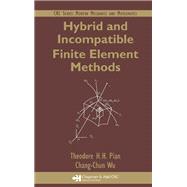
Hybrid and Incompatible Finite Element Methods
by Pian, Theodore H. H.; Wu, Chang-ChunBuy New
Rent Textbook
Rent Digital
Used Textbook
We're Sorry
Sold Out
Summary
Table of Contents
| Variational Formulation of Finite Element Methods in Solid Mechanics | |
| Introduction | |
| Equations for 3-D Elasticity | |
| Conventional Variational Principles in Solid Mechanics | |
| Modified Variational Principles for Relaxed Continuity or Equilibrium Conditions Along Interelement Boundaries | |
| Assumed-Displacement Finite Elements | |
| Assumed-Stress Hybrid-Finite Elements | |
| Hybrid-Strain Finite Elements | |
| Hybrid Finite Elements by the HuâÇôWashizu Principle | |
| Hybrid-Displacement Finite Elements | |
| Foundation of Incompatible Analysis | |
| Introduction | |
| Energy Inequality and Elliptic Conditions | |
| Weak Connection Condition of Incompatible Elements | |
| Numerical Stability of Incompatible Elements | |
| Consistency and Patch Test Condition (PTC) | |
| Generation of Incompatible Functions: General Formulation | |
| Relaxation of PTC by the Revise-Stiffness Approach | |
| The PTC in Curvilinear Coordinates | |
| Equivalent Nodal Load and Calculation of Stresses | |
| Elements for the Theory of Elasticity | |
| Introduction | |
| Four-Node Plane-Incompatible Elements: NQ6 | |
| P2-Linked Incompatible Methods with the Fewest Degrees of Freedom (DOF) | |
| Eight-Node 3-D Solid Incompatible Element | |
| Axisymmetric Incompatible Elements | |
| Hermite Type Incompatible Plate Elements | |
| Bending Model Under Reasonable w-âÇó Constraint | |
| Foundation in Mechanics of Hybrid Stress Elements | |
| Introduction | |
| Energy Consistency Analysis for Incompatible Hybrid Elements | |
| Patch Test and Element Optimization Condition (OPC) | |
| Optimization Method for Hybrid-Stress Finite Elements | |
| Matching Multivariable Parameters | |
| Optimization of Hybrid-Stress Finite Elements | |
| Four-Node Plane Hybrid Element | |
| Penalty Equilibrium Hybrid Element P-S(a) | |
| Three-Dimensional Body 18b-Optimization Hybrid Element | |
| Axisymmetric 8b-Optimization Hybrid Element | |
| Model Optimization of Hybrid-Stress General-Shell Element | |
| Appendix | |
| Numerical Stability: Zero Energy Mode Analysis | |
| Introduction | |
| Definition of ZEM | |
| Rank Conditions for Two-Field Hybrid-Mixed Elements | |
| Determination of the Zero Energy Modes | |
| Control of the Zero-Energy Displacement Modes | |
| Control of the Zero Energy Stress Modes | |
| Patch Stability Test | |
| Examples | |
| Plastic Analysis of Structures | |
| Introduction | |
| Form of Incompressible Elements and Analysis of | |
| Plane-Stress Plastic Analysis | |
| Incompatible Elements in Plasticity Analysis | |
| Deviatoric Hybrid Model for the Incompressible Medium | |
| Computational Fracture | |
| Introduction | |
| Dual Path-Independent Integral and Bound Theorem | |
| Numerical Strategy and Error Measure | |
| Numerical Tests of Crack Estimation | |
| Incompatible Numerical Simulation of an Axisymmetric Cracked Body | |
| Extension of J to Dynamic the Fracture of a Functional Graded Material | |
| Evaluation of Electro-Mechanical Crack Systems | |
| Computational Materials | |
| Hybrid Element Analysis of Composite Laminated Plates | |
| Bimaterial Interface Hybrid Element for Piezoelectric Laminated Analysis | |
| Numerical Solutions on Fractures of Piezoelectric Materials | |
| Homogenization-based Hybrid Element for Torsion of Composite Shafts | |
| A Study of 3-D Braided Piezoceramic Composites | |
| Finite Element Implementation | |
| Overview | |
| Description of Variables and Subroutines | |
| Instructions for Input Data | |
| Examples | |
| Each chapter also contains a complete section of References | |
| Table of Contents provided by Publisher. All Rights Reserved. |
An electronic version of this book is available through VitalSource.
This book is viewable on PC, Mac, iPhone, iPad, iPod Touch, and most smartphones.
By purchasing, you will be able to view this book online, as well as download it, for the chosen number of days.
Digital License
You are licensing a digital product for a set duration. Durations are set forth in the product description, with "Lifetime" typically meaning five (5) years of online access and permanent download to a supported device. All licenses are non-transferable.
More details can be found here.
A downloadable version of this book is available through the eCampus Reader or compatible Adobe readers.
Applications are available on iOS, Android, PC, Mac, and Windows Mobile platforms.
Please view the compatibility matrix prior to purchase.
